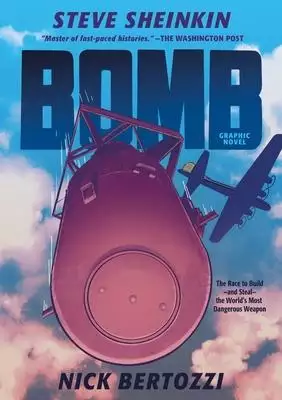arnold的問題,我們搜遍了碩博士論文和台灣出版的書籍,推薦Neumaier, Arnold,Westra, Dennis寫的 Quantum Mechanics Via Lie Algebras 和Sheinkin, Steve的 Bomb (Graphic Novel Edition): The Race to Build--And Steal--The World’s Most Dangerous Weapon都 可以從中找到所需的評價。
這兩本書分別來自 和所出版 。
國立臺南藝術大學 音樂學系碩士班 周郁芝所指導 簡昱恕的 許常惠《留傘調變奏與主題》作品44 之樂曲分析與演奏詮釋 (2021),提出 arnold關鍵因素是什麼,來自於許常惠、小提琴無伴奏獨奏曲、留傘調變奏與主題。
而第二篇論文國立陽明交通大學 電子研究所 簡昭欣、鄭兆欽所指導 鍾昀晏的 二維材料於邏輯元件與記憶體內運算應用 (2021),提出因為有 二維材料、二硫化鉬、二硫化鎢、二維電晶體、記憶體元件、邏輯閘的重點而找出了 arnold的解答。
Quantum Mechanics Via Lie Algebras

為了解決 arnold 的問題,作者Neumaier, Arnold,Westra, Dennis 這樣論述:
The DeGruyter Studies in Mathematical Physics are devoted to the publication of monographs and high-level texts in mathematical physics. They cover topics and methods in fields of current interest, with an emphasis on didactical presentation. The series will enable readers to understand, apply an
d develop further, with sufficient rigor, mathematical methods to given problems in physics. For this reason, works with a few authors are preferred over edited volumes. The works in this series are aimed at advanced students and researchers in mathematical and theoretical physics. They also can ser
ve as secondary reading for lectures and seminars at advanced levels.
arnold進入發燒排行的影片
許常惠《留傘調變奏與主題》作品44 之樂曲分析與演奏詮釋
為了解決 arnold 的問題,作者簡昱恕 這樣論述:
許常惠(1929-2001)為臺灣現代音樂創作的先驅,臺灣民族音樂採集的領航人,是當代臺灣最有影響力的音樂家之一。音樂創作類型包含歌劇、舞劇、清唱劇、管絃樂曲、協奏曲、獨奏曲等。許常惠在學術方面的研究成果也極為豐富,從西洋音樂理論到臺灣傳統音樂皆有專著,代表性著作如《臺灣音樂史初稿》及《民族音樂學導論》等;其對傳統音樂的社會文化價值研究極具開創性視野及見解,能積極促進社會對傳統音樂的重視,並帶動一股風潮。本篇書面報告研究以臺灣當代作曲家許常惠於1991年發表的小提琴無伴奏獨奏曲作品《留傘調變奏與主題》(Variations and Theme on the Folk Tune of “Cat
ching Umbrella”)為主要研究對象。全文共分四章進行論述,首先,闡述研究此曲的動機與目的、範圍及方法。其次,就各方文獻記載研究作曲家生平。其三,解析創作背景,從風格與素材開始,進一步去認識作品的創作脈絡,針對曲式做架構分析,探討演奏的詮釋方法。最後對全文做總結。透過本文的探析,理解該作品之音樂創作思維,提出合宜之演奏詮釋建議,期望能提供未來相關研究者做為參考。
Bomb (Graphic Novel Edition): The Race to Build--And Steal--The World’s Most Dangerous Weapon

為了解決 arnold 的問題,作者Sheinkin, Steve 這樣論述:
A riveting graphic novel adaptation of the award-winning nonfiction book, Bomb--the fascinating and frightening true story of the creation behind the most destructive force that birthed the arms race and the Cold War.In December of 1938, a chemist in a German laboratory made a shocking discovery:
When placed next to radioactive material, a Uranium atom split in two. That simple discovery launched a scientific race that spanned three continents. In Great Britain and the United States, Soviet spies worked their way into the scientific community; in Norway, a commando force slipped behind ene
my lines to attack German heavy-water manufacturing; and deep in the desert, one brilliant group of scientists was hidden away at a remote site at Los Alamos. This is the story of the plotting, the risk-taking, the deceit, and genius that created the world’s most formidable weapon. This is the story
of the atomic bomb. New York Times bestselling author Steve Sheinkin’s award-winning nonfiction book is now available reimagined in the graphic novel format. Full color illustrations from Nick Bertozzi are detailed and enriched with the nonfiction expertise Nick brings to the story as a beloved art
ist, comic book writer, and commercial illustrator who has written a couple of his own historical graphic novels, including Shackleton and Lewis & Clark. Accessible, gripping, and educational, this new edition of Bomb is perfect for young readers and adults alike. Praise for Bomb (2012): "This
superb and exciting work of nonfiction would be a fine tonic for any jaded adolescent who thinks history is ’boring.’ It’s also an excellent primer for adult readers who may have forgotten, or never learned, the remarkable story of how nuclear weaponry was first imagined, invented and deployed--and
of how an international arms race began well before there was such a thing as an atomic bomb." --The Wall Street Journal "This is edge-of-the seat material that will resonate with YAs who clamor for true spy stories, and it will undoubtedly engross a cross-market audience of adults who dozed through
the World War II unit in high school." --The Bulletin (starred review) Also by Steve Sheinkin: Fallout: Spies, Superbombs, and the Ultimate Cold War ShowdownThe Port Chicago 50: Disaster, Mutiny, and the Fight for Civil RightsUndefeated: Jim Thorpe and the Carlisle Indian School Football TeamMost D
angerous: Daniel Ellsberg and the Secret History of the Vietnam WarBorn to Fly: The First Women’s Air Race Across AmericaThe Notorious Benedict Arnold: A True Story of Adventure, Heroism & TreacheryWhich Way to the Wild West?: Everything Your Schoolbooks Didn’t Tell You About Westward ExpansionK
ing George: What Was His Problem?: Everything Your Schoolbooks Didn’t Tell You About the American RevolutionTwo Miserable Presidents: Everything Your Schoolbooks Didn’t Tell You About the Civil War
二維材料於邏輯元件與記憶體內運算應用
為了解決 arnold 的問題,作者鍾昀晏 這樣論述:
半導體產業在過去半個世紀不斷地發展,塊材材料逐漸面臨電晶體微縮的物理極限,因此我們開始尋找替代方案。由於二維材料天生的原子級材料厚度與其可抑制短通道效應能力,被視為半導體產業極具未來發展性材料。此篇論文為研究二維材料二硫化鉬的N型通道元件之製作技術與其材料的特性與應用。首先,我們使用二階段硫化製程所製備的二硫化鉬沉積高介電材料並使用X-射線能譜儀(XPS)與光致發光譜(PL)進行分析,量測二硫化鉬與四種高介電材料的能帶對準,參考以往製程經驗,可結論二氧化鉿是有潛力介電層材料在二硫化鉬上,並作為我們後續元件的主要閘極介電層。接著使用二階段硫化法製作鈮(Nb)摻雜的二硫化鉬,P型的鈮摻雜可提升載
子摻雜濃度用以降低金半介面的接觸電阻,透過不同製程方式製作頂部接觸和邊緣接觸的兩種金半介面結構,傳輸線模型(TLM)分析顯示出,邊緣接觸結構比頂部接觸結構的接觸電阻率低了兩個數量級以上,並藉由數值疊代方式得知層間電阻率是導致頂部接觸結構有較高接觸電阻率主因,並指出邊緣接觸之金半介面在二維材料元件的潛在優勢。在電晶體研究上,我們使用化學氣相沉積(CVD)合成的二硫化鉬成功製作出單層N型通道元件,將此電晶體與記憶體元件相結合,用雙閘極結構將讀(read)與寫(write)分成上下兩個獨立控制的閘極,並輸入適當脈衝訊號以改變儲存在電荷儲存層的載子量,藉由本體效應(Body effect)獲得足夠大的
記憶區間(Memory window),可擁有高導電度比(GMAX/GMIN = 50)與低非線性度(Non-linearity= -0.8/-0.3)和非對稱性(Asymmetry = 0.5),展示出了二維材料在類神經突觸元件記憶體內運算應用上的可能性。除了與記憶體元件結合外,我們亦展示二維材料電晶體作為邏輯閘的應用,將需要至少兩個傳統矽基元件才可表現的邏輯閘特性,可於單一二維材料電晶體上展現出來,並在兩種邏輯閘(NAND/NOR)特性作切換,二維材料的可折疊特性亦具有潛力於電晶體密度提升。我們進一步使用電子束微影系統製作奈米等級短通道元件,首先使用金屬輔助化學氣相沉積 (Metal-as
sisted CVD)方式合成出高品質的二維材料二硫化鎢 (WS2),並成功製作次臨界擺幅(Subthreshold Swing, S.S.)約為97 mV/dec.且高達106的電流開關比(ION/IOFF ratio)的40奈米通道長度二硫化鎢P型通道電晶體,其電特性與文獻上的二硫化鉬N型通道電晶體可說是相當,可作為互補式場效電晶體。另一方面,深入了解二維材料其材料特性後,可知在厚度縮薄仍可保持極高的機械強度,有潛力作為奈米片電晶體的通道材料。故於論文最後我們針對如何透過對元件製作優化提供了些許建議。